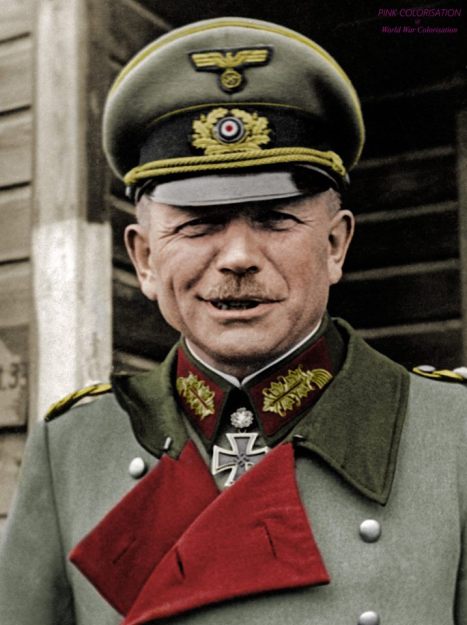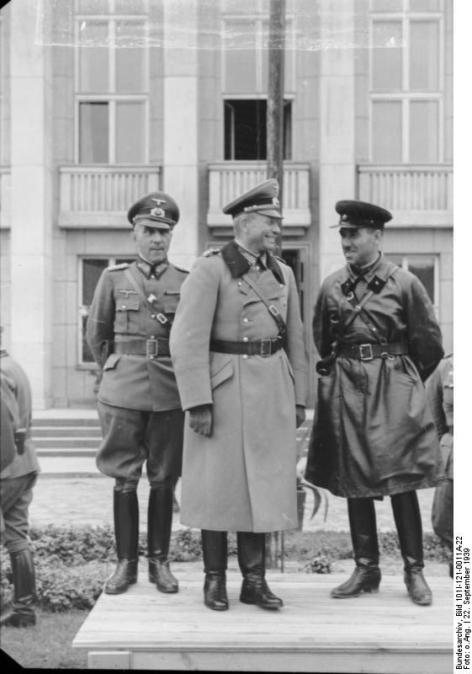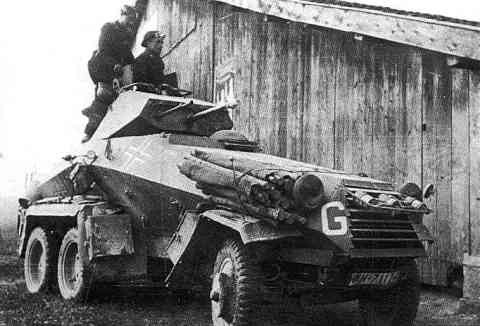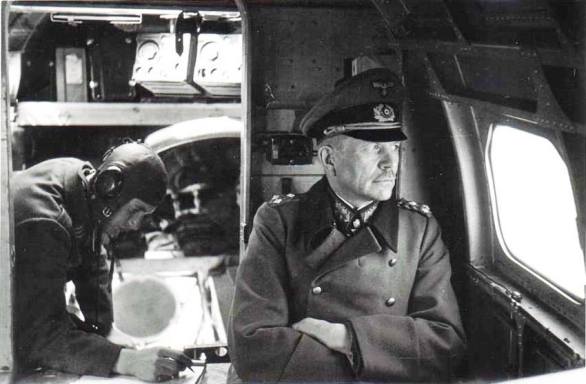[English version at the end]
PERSONAJES DE BARBARROJA
¡Ya a la venta Barbarroja 03:00 hrs!
TENIENTE GENERAL HEINZ WILHELM GUDERIAN (1888-1954)

Heinz Guderian es uno de los más reputados generales de carros de combate de la Wehrmacht. Llegará a ser apodado “el veloz Heinz” por su presteza en conducir las fuerzas acorazadas hacia el corazón de las defensas enemigas. Tras la derrota de la Primera Guerra Mundial y las restrictivas condiciones impuestas por los aliados en el Tratado de Versalles, Guderian es aceptado en el reducido ejército de 100.000 hombres que se le permite poseer a Alemania; es el denominado Reichswehr. Sobresale escribiendo artículos acerca de la motorización del ejército. Pronto será destinado a unidades Kraftfahrzeug-Abteilungen (Batallones motorizados). Se revelará como un defensor a ultranza de la guerra de movimiento aún descuidando los flancos. Tendrá contacto con las tesis de la guerra de movimiento de los británicos Liddle Hart y Fuller, ideólogos de la estrategia acorazada. También Guderian enriquece su visión de la futura guerra móvil con una visita a la URSS de una fábrica de carros combate en Kazán. Cuirosamente coincidirá allí con algunos de los que serán sus más acérrimos adversarios durante la conflagración mundial en ciernes.
A pesar de sus trabajos y ensayos, Guderian se hará famoso con la publicación de su obra más famosa «Achtung, Panzer!«. Gracias a su estancia en la Unión Soviética recogerá además en su libro sus impresiones sobre gigante del este, con cifras detalladas del inventario de vehículos blindados. En Alemania será criticado por algunos de sus propios camaradas de armas por excesivamente fantasioso al hablar de 10.000 carros de combate. Una vez comenzada la Operación Barbarroja el 22 de junio de 1941, el mismo Hitler le confesará a las pocas semanas que de haber creído, como decía Guderian en «Achtung, Panzer!«, que los rusos poseían tal cantidad astronómica de blindados, jamás hubiera dado la orden de invadir. ¡Y Guderian se quedó corto en unos 15.000 carros de combate!

Antes del comienzo oficial de la Segunda Guerra Mundial participa en la operación de anexión de Austria (Anschluss) y la ocupación de los Sudetes al mando de un Panzergruppe en 1938. Al mando del XIX. Armeekorps entrará también en Polonia un año después. Es en 1939 cuando Guderian es nombrado Chef der Schnellen Truppen (jefe de tropas rápidas), a cargo del entrenamiento y supervisión de este tipo de unidades. Pero es en la campaña contra Francia donde más patente muestra su doctrina de movimiento, contraviniendo las órdenes que le son inoportunas para internarse tras las líneas enemigas hasta donde el combustible de sus Panzer le lleve.
Ya una vez iniciadas las hostilidades contra Stalin, manda el 2. Panzergruppe, encuadrado en el Grupo de Ejércitos Centro (von Bock). Junto con el general Hoth y su 3. Panzergruppe, en tiempo récord embolsan a cientos de miles de soviéticos en las batallas de cerco de Bielostok, Novogrudok y Minsk. Él y Hoth, no obstante, fieles a la doctrina de la importancia de no detenerse, dejan a la lenta infantería que se encargue de reducir las bolsas de resistencia. El área de responsabilidad de ambos es Bielorrusia. Guderian conduce el brazo sur de la poderosa pinza blindada en el eje Brest-Minsk atacando el flanco izquierdo del general Pavlov.
Minsk cae en tiempo récord y cruza el gran Dnieper. Sin dilación se lanzará a por Smolensk y la acometerá por el sur; no obstante, este enclave a medio camino de Moscú y a orillas del Dnieper será un hueso más duro de roer. A pesar de capturarlo finalmente, no podrá evitar la evasión de miles de soldados enemigos por un estrecho corredor defendido por el RKKA (Ejército Rojo) a sangre y fuego.
Con fama de arrojado, su manera de hacer la guerra supone un contraste con el proceder en el campo de batalla de von Kluge (Comandante en Jefe del 4. Ejército). Es decir, velocidad y riesgo contra meticulosidad y precaución. Ambos tendrán encuentros muy agrios durante la campaña, especialmente durante unas semanas en el verano, cuando a Guderian se le pone bajo control operativo de Kluge, pasando este último a ser su jefe directo. Guderian se exaspera…
Tras la captura de Smolensk, se produce un parón operativo en la primera semana de agosto de 1941. La Wehrmacht ha avanzado distancias espectaculares sin cesar de combatir y los hombres y las máquinas están agotados. Los comandantes de fuerzas Panzer necesitan motores nuevos y repuestos a una escala no prevista. El polvo ruso ha acelerado el proceso de desgaste de la mecánica de los blindados. Son semanas de incertidumbre en las que el OKW (Oberkommando der Wehrmacht Alto Mando de las Fuerzas Armadas) parece no definirse sobre la idea de continuar hacia la capital de Stalin o no. Incluso Guderian se entrevista con Hitler para intentar convencerle de que Moscú es el objetivo, idea que Hitler deshecha acusándole de no entender los aspectos económicos de las guerras. Hitler está seducido con la idea de los recursos de Ucrania y el petróleo del Cáucaso. Defensor, pues, a ultranza de la idea de tomar la capital como objetivo final de Barbarroja, Guderian contraviene las órdenes de la cadena de mando ocupando el saliente de Yelnya. Un punto expuesto (sudeste de Smolensk) a manera de trampolín, que él estima como esencial para lanzarse contra la capital de la URSS en cuanto le den luz verde. Su tozudez en esta ocasión le llevará a retirarse del saliente en septiembre de 1941 con miles de bajas sufridas. Las órdenes que recibirá, para su sorpresa, no son de continuar hacia el este sino de girar 90 grados a la derecha para caer tras Kiev para una nueva batalla de cerco sin precedentes en la Historia…
¿Querrías conocer los detalles de esta y las demas operaciones?
¡Adquiere la obra cronológica Barbarroja 03:00h en edición de coleccionista!
Sigue interesantes referencias también en Twitter @barbarroja0300h
Deja tu comentario abajo…
[English version]
BARBAROSSA’S PROTAGONISTS
COLONEL-GENERAL HEINZ WILHELM GUDERIAN (1888-1954)

Heinz Guderian is one of the most reknown Wehrmacht’s tank-generals. He is called “Speedy Heinz” due to his ability to move his armoured forces through the heart of the enemy’s defenses. After the German defeat in World War I and the dire restrictions of the Treaty of Versailles, Guderian is accepted in the new 100,000 men army that the Allies allow Germany to raise; it is the so-called Reichswehr. Relentlessly he will release numerous articles about the motorization of the army and is stationed in Kraftfahrzeug-AbteilungenMotorized Battalions. He supports the new art of mobile warfare, that is to bring the fight into the enemy’s heart, even if the cost is to leave his vulnerable flanks unprotected. During those years he will study the armoured doctrines of the British Liddle Hart and Fuller. He will enrich his vision of the mobile warfare thanks to a visit to the USSR (Kazan), when he is invited to a tank factory. Ironically, he will meet some of his future hard-core enemies right there.
In spite of his articles and essays, Heiz Guderian will become famous after the publishing of his book «Achtung, Panzer!» (Beware, tanks!), translated to many languages under different titles. Thanks to his experiences in Russia, he will reflect his impressions about the giant of the East with detailed figures of the future enemy’s inventory. But in the same Germany he is criticized by own comrades of arms for fantasizing about 10,000 Soviet tanks. On the 22nd of June, 1941, once Operation Barbarossa commences, the same Hitler confesses to Guderian that had he kn0wn the real numbers of Soviet tanks, stated by Guderian in his work «Achtung, Panzer!«, he would have never invaded. And Guderian fell short in about 15,000 tanks!

Before the official start of World War II, General Guderian participates in the annexation of the Austrian state (Anschluss) and later in the Sudetenland occupation in command of a Panzergruppe (1938). He will enter in Poland commanding the XIX. Armeekorps (12th Army Corps) a year later. A year after he is appointed as Chef der Schnellen Truppen (Chief of Fast Troops) with responsibility of the training and supervision of this type of new units. But it is during the campaign of France (May-June 1940) where he fully demonstrates his new doctrine of how to wage a modern war. He will ignore «inconvenient» orders in order to breakthrough the adversary’s defenses as far as the fuel of his Panzer can take him.
Once the hostilities against Stalin start he is in command of the 2. Panzergruppe, under Army Group Centre (von Bock). Along with General Hoth’s 3. Panzergruppe, he will encircle in no time hundreds of thousands of Soviet troops in the “cauldrons” of Bielostok, Novogrudok and Minsk. However, along with Hoth, and their belief of never stop, will let the slow moving infantry to take care of the encircled armies, while both of them keep rushing forward. Their area of operations is Belarus. Guderian drives the Southern pincer’s armoured arm along the Brest-Minsk axis attacking General Pavlov‘s left flank.
Minsk falls swiftly and crosses the great Dniepr river. Without respite dashes towards Smolensk to attack it from the South; however, this enclave half-way to Moscow and at the banks of the waters of the Dniepr will be somehow harder to take. In spite of its eventual capture, thousands of Soviets will flee from the encirclement through a tiny corridor free of Germans.
His ideas of the war of movement of mechanized troops will directly clash with von Kluge’s (4th Army) old-fashioned way to wage war. This is the difference between speed and risk versus meticulosity and safety. Both will have sour encounters specially during the summer, when for a few weeks Guderian is set under Kluge’s operational control, consequently being the latter his direct chief. Guderian feels mad about it…

After Smolensk an operational halt occurs up to the first week af August, 1941. The Wehrmacht has advanced impressive distances so fast without stopping fighting and men and machines are exhausted. Panzer commanders need new engines and spare parts in huge quantities. The Russian dust has clogged the filters spoiling the engines of the Panzer. The operational ratio of the Panzer divisions is at its lowest. There’s uncertainty about what direction to take next. The OKW (Oberkommando der WehrmachtArmed Forces High Commnad) hesitates about whether to continue towards Moscow. In this line he will even visit Hitler to persuade him about Moscow as final objective. Reluctantly, Hitler will listen to him, but right after disdainfully will accuse Guderian of being an ignorant on the economic aspects of wars. Hitler is seduced about the resources of the Ukraine and the Oil of the Caucasus. Guderian disobeys several times direct orders as he is also a believer of Moscow as final objective of Operation Barbarossa. Thus after Smolensk he will occupy the famous Yelnya salient, for him a crucial assembly point for the final assault towards Stalin’s capital city. Obsessed with the idea, finally will have to accept the realities of the battlefield and withdraw his badly battered troops off the salient in September, 1941. To his amazement, the orders issued to him are to turn 90 degrees to the right and fall east of Kiev for a new encirclement battle…
Did you find this article interesting? Leave your comments below…
Follow other articles in Twitter @barbarroja0300h



12 respuestas a “Guderian, Heinz. Generaloberst.”